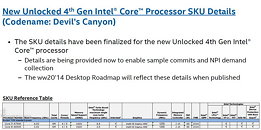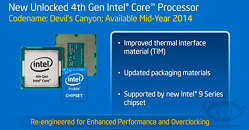Monday, May 12th 2014

Intel "Devil's Canyon" to Usher in 5 GHz-on-air Overclocking Era
Even as Intel launched its first Core "Haswell" Refresh socket LGA1150 chips, it left out two enthusiast-grade parts from the mix, the Core i7-4790K and the Core i5-4690K. Don't be misled into thinking that they're just multiplier-unlocked variants of the i7-4790 and i5-4690 launched today. There's a reason the two have be designated a separate internal codename altogether. Called "Devil's Canyon," the chips are made from high-performing dies binned out from the foundry, and placed on extra-durable packages with contact points that are designed for higher voltages, and a superior thermal interface material between the die and the integrated heatspreader (IHS).
Better packaging (mind the pun) isn't the only thing that sets the i7-4790K and the i5-4690K apart form their non-K counterparts, they're are also clocked higher. The i7-4790K ships with an out of the box clock speed of 4.00 GHz (the first Intel processor to do so), with a Turbo Boost frequency of 4.40 GHz. The Core i5-4670K, on the other hand, ships with a clock speed of 3.50 GHz, with Turbo Boost frequency of 3.90 GHz. The TDP of both chips is rated at 88 Watts, a wee bit higher than the 84 Watts the non-K chips are rated at. Expreview believes that the two could usher in a new era in CPU overclocking without breaking the bank over HEDT chips, and could be capable of running at clock speeds of 5.00 GHz, on air-cooling. Intel is expected to launch the two chips to crowds at Computex 2014, followed by a market release in mid-June.
Source:
Expreview
Better packaging (mind the pun) isn't the only thing that sets the i7-4790K and the i5-4690K apart form their non-K counterparts, they're are also clocked higher. The i7-4790K ships with an out of the box clock speed of 4.00 GHz (the first Intel processor to do so), with a Turbo Boost frequency of 4.40 GHz. The Core i5-4670K, on the other hand, ships with a clock speed of 3.50 GHz, with Turbo Boost frequency of 3.90 GHz. The TDP of both chips is rated at 88 Watts, a wee bit higher than the 84 Watts the non-K chips are rated at. Expreview believes that the two could usher in a new era in CPU overclocking without breaking the bank over HEDT chips, and could be capable of running at clock speeds of 5.00 GHz, on air-cooling. Intel is expected to launch the two chips to crowds at Computex 2014, followed by a market release in mid-June.


59 Comments on Intel "Devil's Canyon" to Usher in 5 GHz-on-air Overclocking Era
Color me severely unimpressed.
At least there doing something and catering to us , could just leave it alone , hopefully price be like before (minor increase) .
Now if they can hit 5.0+ on air for avg chip that would impress me .
tbh i am more interested to know if trigate has finally beaten the coldbug?
(he says, and will probably just get one anyway)
Next, you either misunderstand my intent or I did not convey it correctly. Intel has long since been pushing the clock speeds on successive generations of hardware higher. The truth was so often that you could expect the same overclocking jump. A 2 GHz stock would yield 2.5 GHz overclock; in the following generation the stock clock would be 2.2 GHz, while the OC would be 2.7 GHz (these are ballpark numbers to play with, not hard numbers). The switch from SB to IB to Haswell has yielded the opposite trend. Yes, stock clocks are higher. My problem is OCing has yielded less and less hefty clocks. SB at 5.0 GHz was a strong possibility, but Haswell that high is a statistical anomaly.
Intel seems to be making good on their promise of "catering to enthusiasts." I'm just too jaded by two successive generations of crap thermal paste to really be happy that they've finally realized that only enthusiasts spend money to upgrade, when a 4+ year old chip will likely not be the bottleneck of their systems.
I am interested to see how these actually perform, both OC'ing and temperature wise. Haven't had a chance to really play with a socket 1150 rig yet, this just might be it.
I can't believe how trolled people are @ overclock.net, all claim it won't be and what not, I mean they all take some Chinese rumors for granted, especially when it comes to Broadwell..
While intel CEO/rep said in one YT video conference z87 will be compatible as well.. You can plug the chip into existing systems and 2nd we will have brand new systems z97,..
I posted there 2-3 times, but this bs keeps going on almost everyday, now I stopped all together there, not worth the energy, let people be clueless monkeys lol
Ah the power of interentz xD
Now in some benchmarks Haswell does outperform ivy by a margin with far lower clocks.
I'm probably going to buy one of these devils just for overclocking purposes.
I think these could be some of the dearest consumer cpus we have seen in a long time though which is a shame (for me anyway).
Lets see, maybe we'll get the first 400€/500$ mainstream CPUs...
That said, I confess I'm unimpressed by this. If I were going to upgrade now, given how things are going with Intel CPU's and the unimpressive overall performance improvements they are making and have made over the last three years (SB-IVB-HW-HWrefresh-promise of unimpressive Broadwell gains), I have to say...
I'm thinking in the long run Haswell-E is the better value. You get octa-core, more PCIe lanes, the promise of 2+ SLI/CF, and any advance you particularly like about Haswell (if there are any) except the integrated GPU.
Since I don't use the integrated GPU (because I use SLI and use a dual-DVI 2560x1600 monitor which are unsupported by the DVI built onto motherboards even today), I don't see how spending more on a Haswell-E to have awesome performance for five or more years doesn't make more sense than spending less per year, but MORE over the course of several years for less performance.
Plus a chip with 16 threads (8 cores, 8 hyperthreaded) and a LOT of RAM with superior memory support is incredibly tempting.